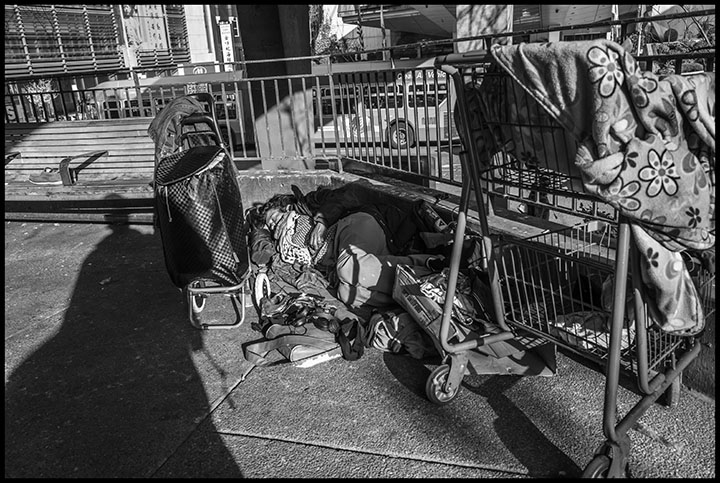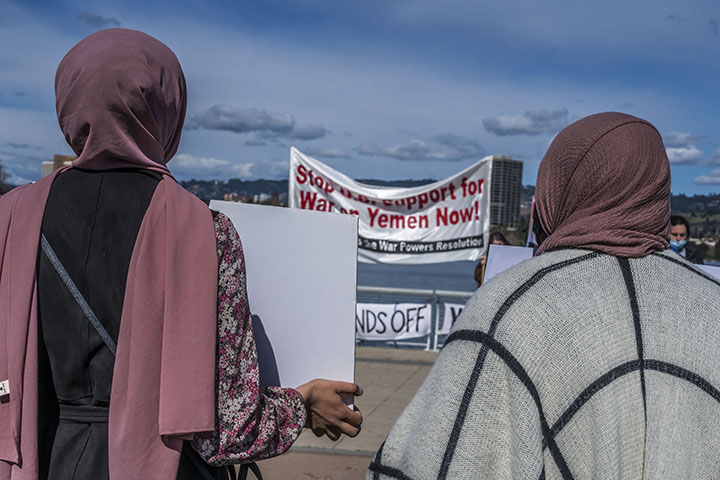TROUBLE IN THE TULIPS
Organized Farmworkers Win Basic Demands in a Quick Strike
By David Bacon
Labornotes, March 30, 2022
https://labornotes.org/2022/03/trouble-tulips-organized-farmworkers-win-basic-demands-quick-strike
Tulip workers take a vote. Photo: Edgar Franks
MT. VERNON, WA - Tulips and daffodils symbolize the arrival of spring, but the fields are bitterly cold when workers' labors begin. Snow still covers the ground when workers go into the tulip rows to plant bulbs in northwest Washington state, near the Canadian border.
Once harvesting starts, so do other problems. When a worker cuts a daffodil, for instance, she or he has to avoid the liquid that oozes from the stem-a source of painful skin rashes.
Yes, the fields of flowers are so beautiful they can take your breath away, but the conditions under which they're cultivated and harvested can be just as bad as they are for any other crop. "Tulips have always been a hard job, but it's a job during a time of the year when work is hard to find," says farmworker Tomas Ramon. "This year we just stopped enduring the problems. We decided things had to change."
On Monday, March 21, their dissatisfaction reached a head. Three crews of pickers at Washington Bulb accused the company of shorting the bonuses paid on top of their hourly wage, Washington's minimum of $14.69. Workers get that extra pay if they exceed a target quota set by the company for picking flowers.
The parent company of RoozenGaarde Flowers and Bulbs is Washington Bulb, the nation's largest tulip grower.
"We've had these problems for a long time," explains Ramon, who has cut tulips for Washington Bulb for seven years. "And the company has always invented reasons not to talk with us."
Workers stopped work that Monday and waited from eight in the morning to see how the owners would respond. The general supervisor was sick, they were told. Someone from the company would talk with them, but only as individuals. "We didn't want that," Ramon says. "We're members of the union, and the union represents us."
Union Wherever They Go
Over two-thirds of the 150 pickers for Washington Bulb work at the state's largest berry grower, Sakuma Farms, later in the season-where they bargain as members of Familias Unidas por la Justicia (FUJ), an independent union. Starting in 2013, farmworkers there struck and boycotted, and finally won a contract after four years. They formed Familias Unidas. At Washington Bulb there is no union contract, yet. But to Ramon and his workmates, they are members of FUJ wherever they go.
When the company wouldn't talk on that Monday, 70 workers voted to strike the following day. Another 20 joined them the next morning, when they again demanded to talk with the company. This time one of the owners told them he wouldn't talk if the president of Familias Unidas, Ramon Torres, was present.
"So we said, 'If you won't talk with our representative, we won't talk without him,'" Tomas Ramon remembers. "'We have a union and you have to make an agreement with him.' So the owner got angry and left."
That Wednesday the flowers were just waving in the breeze, waiting for someone to pick them. The day after, the company lawyer was on the phone to union attorney Kathy Barnard. With a commitment to begin negotiations, workers agreed to go back into the rows after the weekend, and talks got started.
"By the first day of the strike the workers had already met, elected a committee, and put their demands in writing," said FUJ's political director Edgar Franks. "After the four years of fighting for the contract at Sakuma Farms, they knew how to organize themselves quickly. They had community supporters on their picket lines after the first day. They had their list of demands, and finally forced the company to accept it."
Rubber Band Time
When the workers committee and Torres met with Washington Bulb president Leo Roosens on Friday, they went point by point over their 16 demands. Roosens made an oral commitment to resolve all except the demand over wage increases.
Worker leader Tomas Ramon. Photo: Edgar Franks
"The most important one for us was that they pay us for the time we spend putting rubber bands on the ring," Ramon says. Workers have to snap a rubber band around each bunch of flowers they cut, from hundreds of bands held on a ring. Each worker harvests thousands of bunches a day, so putting the bands on the ring takes a lot of time.
"There's never enough time, and supervisors don't want people to stop during work time. So on breaks and at lunch we're still filling the ring. They even give us a bag of bands to take home and do it there."
The company doesn't pay this extra time, so demand #7 says, "All work using rubber bands to bunch flowers will be performed during working time, excluding lunch and rest breaks. This work will not be performed off the clock." "Workers knew they had a right to this, because the union won a suit forcing Washington growers to pay for break time, even for workers working on piece rates or bonuses," Franks says.
Parking, Ointment and Bathrooms
Workers often have to walk half a mile from where they park their cars to the rows where they'll work, which the company also won't pay for. So point 3 says, "Workers will be paid the hourly rate from the time they leave their vehicles in the company's parking lots until they return to their vehicles...at the end of their daily shifts."
Gloves are $30 a pair, according to Ramon, and working without them means getting rashes from liquid from cutting daffodils. "The company has cream you can put on to help with that, but it's in the office and they often won't give it to you. Even if they do, they just give you a tiny bit, not enough." So another demand is for company-provided protective gear, and ointment available in the fields.
Of the eight people on the union committee, two are women. There's often just one bathroom for a crew of 50-60 people, and they included a demand for four bathrooms per crew, two for women and two for men, cleaned every day. They also insisted on a demand for better treatment, prohibiting favoritism from supervisors, who "will be trained to treat workers with respect ... and not pressure workers to pick flowers at unreasonable speeds."
The last demand is that the company recognize Familias Unidas por la Justicia as bargaining representative for Washington Bulb workers. If agreement is reached on that point, it will make the company the second in the state with an FUJ contract.
Strategic Timing
The annual Skagit Valley Tulip Festival is set to start on April 1, and runs for a month. The lightning job action less than two weeks before presented the Roosens, the most prominent family in the tulip industry, with the prospect of picket lines in front of fields, as tourists arrive to take photographs and buy flowers.
Almost all Washington Bulb workers have at least three years doing this work, and some as many as 15. They knew the importance of timing and the company's vulnerability. The fact that they were already organized made it easier to reach a quick decision on a job action.
The decision process relied on the collective traditions of the two indigenous groups from Oaxaca and southern Mexico who make up the workforce, Triquis and Mixtecos. Ramon, a Triqui, explains that "each community talked within itself. Each community has its own process, but we have the same kind of problems and the same experience. We all wanted to make things better, so we reached agreement." In that process community members meet, discuss, and arrive at a decision on behalf of everyone.
At Sakuma Farms, women were not elected to the union's leadership, and within the communities, women took a back seat. At Washington Bulb, however, two women were elected to the union committee, and made specific demands. "That's a big step forward for us," Ramon says. It also gives women in the fields suffering sexual harassment the ability to bring complaints to women in the union leadership, instead of men.
The Bosses' Biggest Fea
"Direct action is what makes things move," Franks says. "People put up with a lot because they're scared that they could be unemployed. But when workers go on strike, they lose that fear, they push back, and that's what makes things move. Direct action is the most valuable tool we have, and the bosses' biggest fear. When workers take that leap of faith they can see the world in a whole new say, and recognize their own true value."
Today in western Washington, a growing number of farmworkers have had that experience, and FUJ is following them into new places and farms as a result. It's not a new idea-in the 1940s, Larry Itliong followed Filipino cannery workers from Alaska, where their pitched battles formed Local 37 of the International Longshore and Warehouse Union, back to their work in the fields of the San Joaquin Valley. There, they became the heart of union organizing until the great grape strike of 1965. They eventually joined with Latino workers to form what is now the United Farm Workers.
"We're trying to make sure not to force the issue with workers here," Franks said. "The union is ready to support them once they're ready to take the step. The issues have been present for 20 years, but now, because of Sakuma, there's an ecosystem they can rely on. They can see workers winning and feel better about taking action than they would have years ago. They have a growing leadership, and don't have to put up with this anymore."
NOTE: At press time negotiations with the company had reached agreement on the workers' list of demands. While the union is not the official bargaining agent, the company agreed to treat the union committee as the representative of the workers. Workers were set to vote on the agreement on March 29.
Striking in the tulips. Photo: Edgar Franks





































